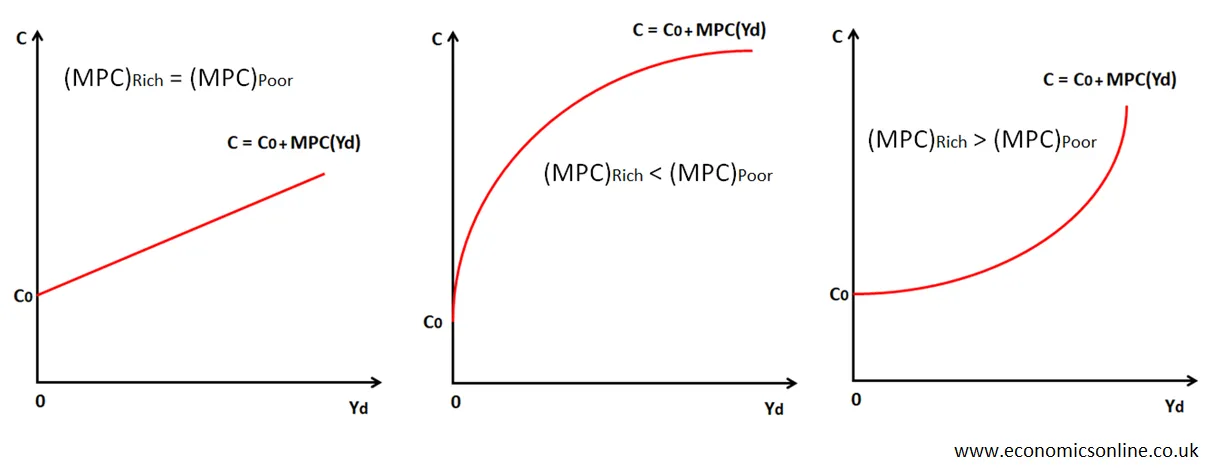
An image showing a shopping mall.
Marginal Propensity to Consume
The marginal propensity to consume (MPC) is a fundamental concept in macroeconomics that measures the relationship between changes in consumer spending and changes in disposable income. MPC is an important concept in determining the impact of changes in disposable income on the economy as a whole. In this article, we will discuss the definition of MPC, its calculation, and its significance in economic analysis.
Definition
The marginal propensity to consume (MPC) is the extra consumer spending arising from an increase in national income. It is the additional consumption because of an additional dollar of income.
In other words, the marginal propensity to consume is the proportion of a change in disposable income that is spent on consumption. It measures how much of an increase in disposable income a household will use to buy goods and services.
On the other side, the average propensity to consume (APC) is the total consumption divided by the total income.
Calculation
MPC is calculated by dividing the change in consumption by the change in disposable income as shown in the following formula:
MPC = ΔC / ΔYd
Where ΔC is the change in consumption and ΔYd is the change in disposable income. MPC is a fraction between 0 and 1, with a value close to 1 indicating that a household spends nearly all of its increase in disposable income on consumption. On the other hand, a value close to 0 indicates that a household saves nearly all of its increase in disposable income. MPC of 0.5 means that $0.50 is consumed out of every extra $1 income.
MPC and the Consumption Function
The consumption function, also known as the Keynesian consumption function, is a theoretical relationship that represents the relationship between consumer spending and disposable income. The equation of the consumption function is typically represented as C = a + bY, where C is consumption, Y is disposable income, a is the autonomous consumption (spending that occurs independently of income), and b is the MPC. The MPC represents the slope of the consumption function and shows the extent to which an increase in disposable income leads to an increase in consumer spending.
MPC determines the shape of the consumption function.
- MPC is constant for a straight line consumption function – (MPC)Rich = (MPC)Poor
- MPC is increasing for an increasing sloped consumption function – (MPC)Rich < (MPC)Poor. This is practical and shows that lower income levels produce a higher MPC than higher income levels. Lower-income households tend to have a higher MPC because the money they spend on daily expenses is typically a larger proportion of their income than the high-income households.
- MPC is decreasing for a decreasing sloped consumption function – (MPC)Rich > (MPC)Poor

Significance of MPC
MPC is an important concept in macroeconomics because it helps economists understand the relationship between changes in disposable income and changes in consumption. Understanding this relationship is critical in forecasting economic growth, inflation, and the business cycle.
MPC and the Multiplier
The MPC plays a key role in determining the size of the multiplier due to a change in autonomous spending. The larger the MPC, the greater the multiplier effect and the greater the impact of a change in autonomous spending on the economy as a whole.
The strength of the multiplier is directly related to the marginal propensity to consume (MPC).
The multiplier is calculated as 1 / (1 - MPC). The higher the MPC, the greater the value of the multiplier, and vice versa. If the MPC is 0.8, for example, then the multiplier is 1 / (1 - 0.8) = 5, meaning that a change in autonomous spending of $100 would result in a final increase in income of $500. If the MPC is 0.6, then the multiplier is 1 / (1 - 0.6) = 2.5.
The strength of the multiplier is directly related to the MPC. The higher the MPC, the greater the multiplier, and the greater the impact of a change in autonomous spending on the economy as a whole.
MPC and Economic Growth
MPC is also used to analyze the impact of changes in consumer spending on the economy. An increase in consumer spending leads to an increase in demand for goods and services, which, in turn, leads to increased production and economic growth. If the MPC is high, a small increase in disposable income can lead to a significant increase in consumer spending and, therefore, economic growth.
MPC and Inflation
MPC is also used to analyze the impact of changes in government spending on the economy. An increase in government spending (fiscal stimulus) leads to an increase in aggregate demand, which can cause inflation if the economy is operating at or above full employment. MPC is used to estimate the impact of changes in government spending on inflation by taking into account the extent to which the increase in disposable income is spent on consumption.
MPC and Consumer Confidence
Higher MPC in a country shows higher consumer confidence and vice versa. This is vital for government in policy making. For example, if goverment is using an expansionary fiscal policy by cutting income taxes (tax cuts), due to increase in consumers' disposable income and a higher MPC, there will be a great economic stimulus to the economy.
Conclusion
In conclusion, the Marginal Propensity to Consume (MPC) is an important concept in macroeconomics that measures the relationship between changes in consumer spending and changes in disposable income. MPC is used to analyze the impact of changes in autonomous spending, consumer spending, and government spending on the economy. Understanding the MPC is essential in forecasting economic growth and inflation.


